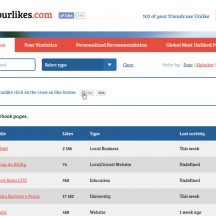We met with David during the first Social Media Barcamp in Central Europe – BabelCamp in Brno. Back then he was talking about influencers and their role. And this seemed to as a very interesting topic. However, in the interview he talks not only of influencers, but also about his influencer targeting app BrandVee or the startup community in London and Budapest.
What was your road to a social media startup? You were involved in online marketing before, with your company Dandi Interactive, but in general – what made you pursue this path?
Dandi Interactive was our previous company. It was plain simple back then: I really enjoyed marketing since it is about delivering the right products to the right people. I love the Hungarian word for sales (értékesítés) which means creating value for others. It’s a kind of a passion for me and my experiences from my previous company showed me that there are a lot of business people out there who are having trouble with creating value.
We met at the CEE social media conference in Brno – BabelCamp, where you presented BrandVee. You spoke a lot about influencers and getting to know your audience better. Do you think that Facebook Insights don’t provide enough information?
They do but in my opinion the tool misses one simple fact: the future of business is personalization. We all hate spams, don’t we? What is spam? It can be an unwanted e-mail, an offer or an ad that we are not interested in. Spam is marketing gone wrong and we can eliminate this if we personalize businesses. BrandVee helps companies create personalized customer experiences in social media while leveraging influencer marketing.
Can you describe the role of influencers and how a brand will help finding and defining them?
On Facebook, we have Fan Pages where not only administrators but the community itself creates content. The question is who is the most responsible for the Fan Page appearance? Who shapes that community? It is never one single person but a group of the most active, most engaged influential people. They are influencers because they help you to decide what to think about a Fan Page when you visit it for the very first time. If a brand can use this fact, their social strategy will leverage one of the most natural aspects of human behavior: similar things attract similar people.
Is it really so? Most Page fans seldom visit the page itself, they only interact with it if they see it in their newsfeed. Moreover, once you have a page with a bigger impact (10k+ fans), there will often be two or more ‘core’ groups of fans with different needs and affiliations. Let me give you an example – the MINI. Page tries to keep the balance between the fans of the MINI and the fans of the old Mini brand – these two groups don’t often like each other much. How can you cope with this?
I assume these are two different issues. First, it is true that the fans mostly interact with the contents in their newsfeed but you can still ask who would interact and why? The fans mostly consume the content because they find it relevant and as long as they do so regularly, we can say they are engaged. This is a kind of loop since Facebook’s EdgeRank rewards the Page if a user consumes the Page content regularly. But based on the recent changes made in the Facebook newsfeed, it is clear that the company is pushing the Fan Page administrators towards ad buys since you simply cannot get enough reach through organic content. So basically you need a tool that can tell you effectively how you should target your ads to maximize the potential outcome (engagement).
Another question is pretty interesting. If there is a change in the social strategy, two major core groups can exist in the community. But in the course of time, the “original” core group will erode and the new core group will more likely consider the new contents compelling and engaging. And if there is a change in the fan behavior with time, you just need an algorithm that can reveal this.
I get the point of downloading a list of active users (FB IDs) and using it. But what else is there in terms of influencers? And how can you know the “good” guys from the bad guys? An obvious troll hurting your Page and reputation will be probably one the most active fans too.
BrandVee does not use any text processing algorithm; we only use high level data. However, our Influencer Analysis does not only tell who the most active person was but it also evaluates the quality of such activities.
This means that if a user was trolling, his activity will be most likely ignored in the list. The reason for this is simple: there are two different kinds of trolls when it comes to complaining and ruining communities. Some trolls just complain only under one or two posts; this activity can be totally ignored. Other trolls, however, keep commenting and insulting others, which means they are active under several posts regardless of their content. Our algorithm distinguishes posts based on the level of engagement, i.e. only the fans who are engaged with the most popular contents, not with posts with a low engagement value, will be considered highly influential.
There are many competitors in the field you want to compete with, many of them employing tens or even hundreds of people. Don’t you worry that the moment you succeed in getting your message out (e.g. someone outside of Hungary like TechCrunch will write about you) – they might simply learn what you offer and copy it? Do you believe you have the kind of know-how which can hardly be copied? Or you don’t mind?
We are heading towards an independent platform, a custom way to solve our clients’ problems while getting an exceptional experience. Also the algorithm we have been building in the past few months is unique, and hard to copy. But one simple algorithm cannot give you sustainable competitive advantage, so we rely on focus. This is more of a strategy than a fact. If there is a new player who does the same thing as we do and if they are a big company, no problem, we’ll move forward. BrandVee is a small and agile player in the market right now, so we can quickly respond to the market changes. This is the true advantage against a big competitor.
Back by the end of 2013 we published a short article about another service aiming at the influencers – iPyro.me from Serbia. They use a different approach – finding the influencers first and then making them write about your stuff. And then there’s BrandVocat (a Hungarian start-up too) that wants to use the gamification mechanisms to motivate influencers and fans to share the news about the brand. So it seems that influencers do play an important role, but how to approach them in a personalized way?
Influencers serve one clear purpose: to create the ROI based approach to social media. As for personalization, imagine you run a Fan Page where you start a campaign with an app. You want to differentiate what app users are most likely to purchase something in your web store to retarget them in a personalized way. What should you do? First, figure out the connection between their social activity and their purchase behavior. Then, prioritize the users who are most likely to buy and retarget the audience. Third step: make your campaign personal – use names, birthdays, the products the fans are most likely to buy, etc. Note that in this process you simply integrate the existing platforms (the web store and social media) and leverage the info they provide to maximize the customer experience.
Ultimately, this will lead you to an ad saying “Adam, we’re offering you 20% off of our (insert product here), since you (insert event here).” How often do you see ads calling you on your first name? It’s so easy but many marketers miss it.
Who would you say BrandVee is best for? Is it best suited to advertising/media agencies or for companies to use directly?
Well, our technology is used for targeting Facebook advertisements. The best results come from FMCG (Fast-Moving Consumer Goods) and media industries. I could say: if you are a marketer typing “How to get greater ROI on Facebook?” into Google, BrandVee is your solution.
Let’s move from theory to practice. You’ve already run a number of campaigns and cooperated with different brands. Can you give us some real life numbers? Which companies benefited the most? Are there some creative examples other than simply creating ad campaigns using the ‘similar audience’ model?
We looked at engagement per click rates, which tells us how we succeeded in finding relevant users. The average number before our campaigns was 0.67, which means that every second user who clicked engaged some kind of contents. After 3 months of using BrandVee for targeting, we experienced, that this ratio moved up to 2.09, suggesting that every user who clicked engaged with at least two kinds of contents on the page on average. This is a 4x improvement, which our clients considered impressive, since the costs of getting these engagements were dropped by more than 50%. For engagement, I’d say that FMCG and media companies can benefit the most, and here’s another interesting use case. An online bookstore started to use our audiences, which eventually doubled their CTR. For a web store, an ROI calculation can be easily done on this.
BrandVee is still presented as a start-up, are you looking for more investors?
Right now we are working together with Sabie Valner at Digital Factory, which is a startup accelerator in Hungary. We are actually raising money, especially from investors with experience in adtech.
If we understand it correctly, you want to be a freemium service, don’t you? What is your business model?
There is a very important lifecycle stage in our development. With Facebook’s Ads API, we’ll be able to build a fully functional ad management platform, it’s pricing will be based on the ad spend. Unlike other players, we don’t need minimum monthly spend or fees. Based on our experience, we can promise to get you four more relevant fans at lower costs by our targeting technology.
We have read your recent post about your visit in London on Medium and you seem to be blown away by the start-up ecosystem over there. What do you miss in Hungary?
The volume. The evolution of the start-up ecosystem here in Budapest and in London started almost at the same time. But London had a head start because there are more companies, more people there. But we have a great advantage even compared to the US: there are dozens of talented tech people in our region. In London, I saw walls covered with post-its, all looking for developers. This is uncommon here.
Another thought on the differences: as a start-up from Budapest, our main goal is the Silicon Valley, of course. It’s the heart of this world. Our main concerns before incorporation were taxes, employment issues, international affairs, and so on. We decided to establish our business in the UK and operate mainly from Hungary. Building a company from CEE is much cheaper and this is our big advantage.
If you have something with a global demand, you can start it from anywhere, but if you don’t, then you’re screwed up anyways. We raised money in August, it lasted for six months here but it would have barely covered two months in the US. Personally, I see London as the next stop, then the US. There are really no boundaries but we needed to find the right way to enter the market.
With BrandVee you aim for better statistics and good analytics. How do you feel about the buzz around big data? Does it affect your application?
It’s hype, definitely. Yesterday it seemed to be unbelievable to handle such data, today we call it big data, and what about tomorrow? We all know that the amount of data in the world is doubled every eighteen months, so what is big data exactly? It’s like sex in high school. Everyone talks about it, everyone claims they are doing it, but no one has a clue what the hell it is.
Are you planning on running a blog for your website? I believe many people would appreciate advice on how to work with influencers and make use of the data they got using your application.
Sure, we have several topics to talk about. In the last eight months we experienced lots of facets of social marketing thanks to our partners and customers from all over the world, so we are planning to share some pretty impressive resources on our blog in the future.
What about your BrandVee Facebook Page? On your website, there has been a link to the old page that no longer works and the new one is not updated very often 😉
That’s a funny question. We have a Facebook Page, but in the alpha tests we relied on personal contacts (personalization business, the oldest one), so we didn’t really bother to manage our Facebook Page. It is about to change though; as I said we have dozens of topics to talk about.
This interview was prepared by Dávid Tvrdoň (@davidtvrdon).
More Social Media Reviews
An epic story of how to get over 100,000 clicks dirt cheap
Most professionals know very well that hidden in fifty shades of gray there is an area of Facebook marketing that…
Read more








